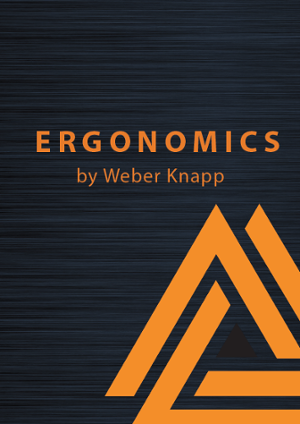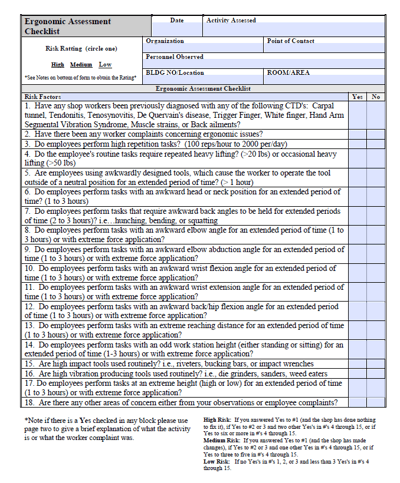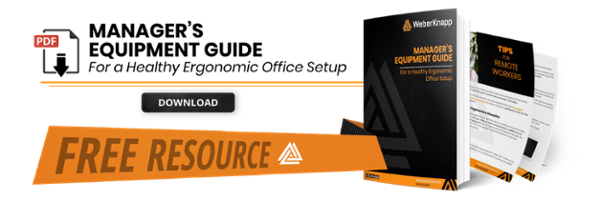
As workplaces change and technology moves forward, innovative ergonomic solutions are making a big difference in creating healthier, more comfortable spaces for employees.
The latest ergonomic trends for 2025 aren’t just passing fads – they’re built on timeless principles. Like a classic design, great ergonomics always prioritizes comfort, support, and ease of use.
Bringing these solutions into your workplace allows you to create an environment where employees feel supported and can work more comfortably.
Let’s look at how a well-thought-out ergonomic setup can make a lasting impact and consider some standout solutions.
Why Are Innovative Ergonomic Solutions Important?

Ergonomics is a field of science that brings together multiple disciplines to improve working conditions and products, aiming to boost comfort, safety, and productivity.
At its core, ergonomics focuses on the physical abilities and limitations of the human body in relation to tasks, tools, and environments.
Why is ergonomics important in the workplace? Or, what is the purpose of ergonomics in the workplace?
The purpose of ergonomics in the workplace is mainly to prevent injuries, especially musculoskeletal disorders (MSD).
Soft tissue injuries are caused by exposure to repetitive force, motion, and vibration, and poor body positioning. Common MSDs include:
- Carpal tunnel syndrome
- Tendonitis
- Bursitis
- Herniated discs
- Trigger finger
To help prevent these injuries, everyone – from team managers to building designers to product engineers – should look at the relationship between our tools, tasks, and environments, and the human body’s abilities and limitations.
Ergonomics for a Thriving WorkforceImprovements in health and safety have allowed many employees to stay in the workforce longer, bringing invaluable experience and expertise to their roles. However, with longer careers can come challenges like musculoskeletal disorders (MSDs), such as back pain, that may require extra care and attention. By prioritizing ergonomics, workplaces can help support employee comfort and well-being, enabling team members to thrive throughout their careers. Investing in ergonomic solutions helps create environments where employees of all ages can work comfortably and productively for years to come. |
Classic Ergonomics: Timeless Solutions
Whether it’s an office, construction site, or medical facility – and no matter the year, 1925, 2025, or beyond – good workplace ergonomics always matters. It’s a timeless priority that never goes out of style.
What innovative ergonomic solutions for the workplace will continue to endure in 2025 and beyond? Those that focus design on reducing physical stress on workers’ bodies and preventing MSDs with:
- Tools & Equipment
- Furniture
- Training
Tools & Equipment
For almost every profession, tools and equipment are being designed with ergonomics in mind, such as:
- Hand tools (hammers, utility knives, drills, etc.)
- Keyboards
- Mouse trays
- Keyboard trays
- Tablet holders
- Monitor arms
- Computer carts
- Book lifts
- Multi-monitor setups
- Blood draw armrests
- Desks
Weber Knapp’s History of Ergonomic InnovationOur journey into ergonomics began four decades ago in the early 1980s. At that time we manufactured one of the first office furniture adjustable keyboard arms. That one keyboard arm was just the beginning for us and has opened up an entirely new world of innovative opportunities for our engineering team throughout the past 40 years. |
Furniture
Healthier, happier employees are more productive, whether they’re sitting, standing, or on the move. One of the benefits of a well-designed ergonomic work environment is having furnishings that directly impact this.
Examples of ergonomic furniture include:
- Height-adjustable desks
- Chairs with armrests
- Stools
- Footrests
- Rolling filing cabinets
Training
 Ergonomics training is a tremendously important piece in creating a more ergonomic workplace. Even with all the ergonomically designed tools, equipment, and furniture in the world, without proper training, you won’t get back nearly as much as you’ve invested.
Ergonomics training is a tremendously important piece in creating a more ergonomic workplace. Even with all the ergonomically designed tools, equipment, and furniture in the world, without proper training, you won’t get back nearly as much as you’ve invested.
The best ergonomics training programs help everyone in a work environment understand:
- The ideas and execution of ergonomic principles
- Proper use of equipment, tools, and machines
- Good lifting techniques
- Warning signs and early symptoms of MSDs
Bringing It All Together
You know what ergonomics is, why it’s important, and what ergonomically-designed tools, equipment, and furniture are available. Now how do you make it all come together? With an ergonomics assessment.
What is an ergonomics assessment?
Ergonomic assessment checklists help employers evaluate the physical environment of their workplace, including:
- Workstations, tools, and equipment – Are these designed for individual adjustments and best ergonomic practices?
- How employees use them – Have team members been trained to fit their work environment to themselves and not vice versa, i.e. adjusting their workstations to their bodies and not their bodies to their workstations?
- Lighting – Often overlooked, it’s important that lighting be sufficient to prevent eye strain. Mitigate the glare of overhead lighting with task lights.
- Temperature – If your workspace is too hot, it can cause dehydration and fatigue. Too cold: stiff joints and muscle strain.
By conducting regular ergonomic assessments, you can proactively identify potential hazards and make necessary changes.
It’s best to create a comprehensive ergonomics program including:
- Assessing current workplace practices
- Providing training for employees on proper body mechanics
- Creating an ergonomics policy
- Developing an action plan
Upgrading Ergonomic AssessmentsArtificial intelligence (AI) seems to be taking over -- and not in a "taking over the world" sense. Rather, there's almost no industry or process that's not set to benefit from its capabilities. Ergonomic assessments are no exception. Given the rapid advancement in AI during the last two years, it should come as no surprise that this technology will see more use in the next year to make evaluations and recommendations for workplace ergonomics. With the ability to analyze large sets of data, as well as various factors such as workspace layout, equipment use, and employee behaviors, AI can determine correlations and patterns. Using this information, AI can predict potential ergonomic issues and suggest improvements to prevent discomfort or injury. For instance, AI can recommend adjustable chairs, sit-stand desks, or specific computer monitor placements based on individual needs and preferences. What’s more, AI-powered systems can provide dynamic recommendations, adapting to ongoing changes and emerging trends in workplace ergonomics. |
Lighten the Load
We’ve covered the classics of ergonomics, but while you’re performing your workplace ergonomic assessment, keep in mind the following features in your work environment that could be causing employee strain:
- Heavy lids
- Heavy doors
- Heavy hinged countertops
Integrating counterbalance hinges with weight mitigation and motion control allows users to safely operate equipment with heavy lids or doors by decreasing the amount of force needed to lift or open them.
Mindful mechanical motion control system integration also reduces the risk of repetitive motion injuries.
See the safety features of our counterbalance hinge motion controls:
Innovative Ergonomic Solutions for Your Workspace
Ergonomic solutions come in many forms, all designed to help create healthier, more comfortable work environments.
The right combination of furniture, tools, and training can provide employees with spaces that reduce the risk of injuries like MSDs while supporting their productivity.
Choosing these innovative ergonomic solutions today means setting your team up for long-term comfort and success, with benefits that will carry your business forward.
Take the Next Step in Ergonomics
Download our free Manager’s Equipment Guide to create a safer, more comfortable workplace for your team.
This piece was originally published in May 2022 and was recently updated to reflect industry trends.
.png?width=12000&height=2033&name=WeberKnappLogo_white%20(1).png)



